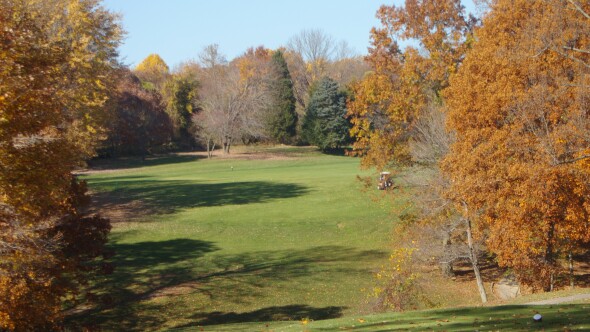LAYTONSVILLE, Md. -- The best advice for those playing Blue Mash Golf Course is this: Get there early, head to the practice area and hit a lot of drivers.
That's the only way to prepare for the first five long, tough holes at the oddly named course tucked in an unusually quiet corner of otherwise bustling Montgomery County.
Blue Mash sits on land that few would have considered for a golf course. A sanitary landfill, a power substation, thick woods and a nursery border it. There are no surrounding homes, but cars whiz by on a two-lane thoroughfare that buzzes the 18th hole. There's even a hulking power line that splits the course in two -- the front nine to the north and the back nine to the south.
But this transitional piece of property was just the ticket for developers and Notre Dame graduates Tom Healy and Joe Hills, who recognized the potential of the lowland known to locals as "Blue Marsh."
Opened in 2001, Blue Mash filled a glaring need. In a wealthy county with plenty of open space, there wasn't a single upscale public course. For years, players had to travel west, just over the county line, to reach the quality public golf courses of Frederick County.
There is a reason for the paucity of upscale public golf in Montgomery County. As one of the most liberal jurisdictions in the nation, regulations -- environmental and otherwise -- put a stranglehold on golf course development.
That is why it took more than 10 years to build Blue Mash. Locals agree, however, that it was worth the wait.
Blue Mash Golf Course's monster start
Few golf courses start with such a power test as Blue Mash. Consider these opening holes: A 449-yard par 4, 452-yard par 4, 478-yard par 4, 206-yard par 3 and 580-yard par 5.
Whew!
The good news on the starting five is that the fairways are wide, the trees are sparse and there are no water hazards.
With the longest par 4 and par 5 out of the way, the rest of the 6,885-yard course (73.0 rating/134 slope) is plenty manageable with lots of risk/reward holes and birdie opportunities.
Hills, the son of prolific designer Arthur Hills, collaborated with his dad to create a fascinating course full of variety and dramatic snapshots -- many of them framed by golden knee-high fescue, which gives Blue Mash a windswept Scottish look. Don't sweat the tall grass as it is largely decorative and rarely in play.
Seven holes are over open pastureland. Six play through woodlands. Water is the dominant theme on the other five, including the signature 17th, a 192-yard stress test with woods on the left and a lake on the right with no room to bail out.
Much care and thought went into shaping the green complexes at Blue Mash. On a course with generous fairways, the difficulty increases as players reach the fast, undulating greens. Approaches and even chip shots deserve careful consideration as it is more imperative to keep the ball below the hole than at most courses.
The best holes at Blue Mash are near the turn. No. 8, a 310-yard dogleg par 4, can be reached with a powerful drive, which also brings deep bunkers into play. On no. 9, a downhill 548-yard par 5, a pond is a factor on both the drive and the approach. Players can go for the gusto, although a conservative approach will still leave them with a wedge to the green and a birdie opportunity.
The most attractive holes are nos. 10, 11 and 12, which play around the same lake. The 217-yard 11th, mostly over water, is long and tough, but allows the option of bailing short and left. Players who give up a shot or two on the hole can get them back at no. 12, Blue Mash's most reachable par 5 at 500 yards, downhill.
Blue Mash Golf Course: The verdict
Long-awaited and long overdue, Blue Mash was a revelation when it opened in 2001 as a one-of-a-kind facility in Montgomery County.
After some early challenges, the course has matured beautifully, drawing a faithful legion of serious players and giving the course a private feel.
Those players tend to flock to the manicured practice area, which might be the best for a public course in the Washington, D.C. area. It includes grass tees, multiple targets, and chipping and putting greens, which accurately replicate the challenge that awaits on the course.
The clubhouse follows suit with locker rooms, showers, a quality dining room and a veranda that overlooks the most attractive part of the course.
Considering everything that Blue Mash offers -- including the proximity to the Beltway, the excellent conditions and the interesting, challenging layout -- there are few public courses in the Washington, D.C. area that can compare.
















